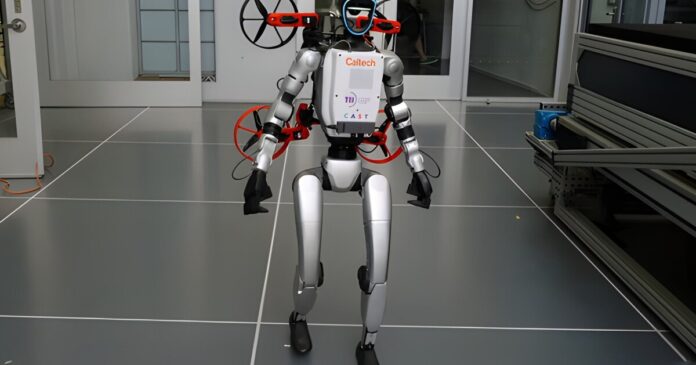Like something out of an early Transformers movie, researchers at Caltech have just demonstrated how a humanoid and a drone can team up to accomplish multiple forms of movement. The experiment opens new possibilities in robotic locomotion.
“Right now, robots can fly, robots can drive, and robots can walk,” says Aaron Ames, professor of mechanical and civil engineering, control and dynamical Systems, and aerospace at Caltech. “Those are all great in certain scenarios. But how do we take those different locomotion modalities and put them together into a single package, so we can excel from the benefits of all these while mitigating the downfalls that each of them have?”
To answer that question, Ames and his team started with an off-the-shelf G1 humanoid made by China’s Unitree robotics company. They then mounted Caltech’s M4 bot to its back and named the merged system X1. The M4 is a drone-like robot that can fly and then rotate its rotor guards to become wheels, allowing the bot to roll along on the ground.
Next, the team executed a demonstration scenario in which the loaded-up humanoid walked outside, bent from the waist, and allowed M4 to take off from its back. The M4 then landed and rolled along until it met a turtle pond, at which point it became airborne again to zip over the obstacle. You can watch it all take place in the following video.
Robotic Synergy: A Humanoid and M4 Collaborate to Achieve a Common Goal
While the demonstration might seem simplistic, it took the Caltech researchers about three years to handle all of the logistics of merging the two robotic systems. For starters, they modified the Unitree bot to be able to navigate on its own rather than simply repeated movements it observed from humans. And they had to make sure it could account for the alteration of balance created by the M4 mounted to its back.
“The robot learns to walk as the physics dictate,” says Ames. “So X1 can walk; it can walk on different terrain types; it can walk up and down stairs, and importantly, it can walk with things like M4 on its back.”
The project was a collaboration between Caltech’s Center for Autonomous Systems and Technology, which is the group that built the M4 robot; the Ames Lab, which focuses on locomotion and algorithms dictating the safe use of robots; and TII, a group that specializes in the sensing and autonomous abilities of bots.
“We’re thinking about safety-critical control, making sure we can trust our systems, making sure they’re secure,” Ames says. “We have multiple projects that extend beyond this one that study all these different facets of autonomy, and these problems are really big. By having these different projects and facets of our collaboration, we are able to take on these much bigger problems and really move autonomy forward in a substantial and concerted way.”
You can learn more about the collaborative effort that led to the development of X1 in the following video.
A Symphony of Robotic Motion – Collaboration Between Caltech & TII
Source: Caltech


